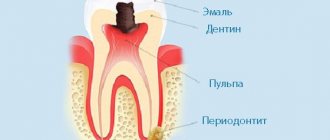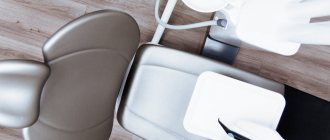- Is there pain during implant placement?
Before implanting an artificial root, the gum at the installation site is pierced or cut.
The installation site is formed using a miniature drill. An implant is installed in the resulting bed, on which the orthopedic structure is fixed. As after any surgical intervention, the postoperative period is associated with pain. Essentially, pain signals the body to pay attention to that area. In this article, we will understand what causes pain after implantation, how to reduce it, in which cases you need to seek help from a dentist, and much more.
Can a dead tooth hurt?
Before answering this question, let’s find out what the concept of “dead tooth” means? This is the common name for a tooth in which, for medical reasons, the pulp has been removed - loose fibrous tissue penetrated by nerve endings, blood and lymphatic vessels. We are talking about depulpation (removal of the pulp) in case of inflammation for various reasons: due to advanced caries, fistulas, cysts, etc.
Calling a pulpless tooth “dead” is not entirely correct. It is indeed separated from the circulatory system and the nervous system, but is still a component of the dentofacial apparatus, where each element affects the condition of the others.
Pain in a tooth with a removed nerve most often means that other parts of the system are involved in the pathological process, “transmitting” unpleasant sensations to the tissues associated with this tooth. Thus, a false impression is created that the pulpless tooth hurts.
Let's sum it up
Pain after insertion of a pin occurs for various reasons, but moderate pain is normal. The maximum time through which they must pass is up to five days. If the pain lingers for a longer period of time, it is necessary to consult a doctor who will find out what caused the pain.
However, if erroneous and unprofessional actions of the dentist were noticed, which include installing the rod too deeply, non-compliance with the rules for filling the root canals, damage to them with dental instruments, an incorrectly fixed pin and pieces of dental instruments accidentally left in the canal, then the pain is usually very intense and you need to get rid of it only after consulting a doctor.
Why does a dead tooth hurt when pressed?
Pain in a tooth without a nerve when biting or pressing can be due to various reasons, and is not necessarily explained by pathology. In the first days after depulpation, discomfort when pressing occurs as a reaction to the procedure itself.
It should be understood that nerve removal and preparation for filling is a microsurgical operation that is impossible without tissue injury. First, the dentist drills out the tooth cavity, then, using special tools - an apex locator and needles of various tapers - penetrates the root and extracts the nerve. Then anti-inflammatory and antibacterial drugs are placed into the cleaned channels.
Post-filling pain
If a filled tooth with a removed nerve hurts for some time, this may be normal, as it can be explained by objective reasons.
- In preparation for a filling, slight damage to the healthy tissue involved in the process may occur. Most often, this is the cause of pain in a dead tooth when pressed. Pains of this origin are called post-filling; they are moderate in nature and, as a rule, disappear after a few days. To relieve discomfort, the doctor usually prescribes painkillers.
- Unpleasant sensations may arise due to the characteristics of the filling material, which expands slightly when entering the root canals and creates pressure on the apex. These pains are temporary and disappear without a trace after a few days.
Intense pain in the tooth under the filling, its sharp increase a few days after the filling and the absence of a tendency to subside after one or two weeks are no longer the norm. This indicates the presence of complications and requires an urgent visit to the dentist's office.
Poorly performed treatment
The cause of pain in a treated tooth due to mechanical action (pressure, biting) may be errors made during endodontic treatment.
- Perforation of the tooth root.
Improper treatment can result in the filling paste extending beyond the root apex into the jawbone tissue. Inflammation under the tooth develops around the foreign body, causing first bursting and then throbbing pain. - Incomplete closure of root canals.
If the length of the canal is incorrectly assessed after filling, part of the cavity remains unfilled, infection develops in the voids, and as a result, when tapped, a tooth without a nerve hurts. - Incomplete depulpation.
If a tooth without a nerve hurts when pressed, this may indicate that the pulp was removed poorly and living tissue remains in the canals. - Poor saliva evacuation.
As a result, pathogenic microorganisms can enter the canal cavity along with the remaining saliva, which leads to tissue infection and pain. - A fragment of a tool in the canal.
Very thin needles used to examine tooth root canals sometimes break and some remain inside, serving as a source of pain and infection. - Specific root structure.
The condition for successful treatment is a completely sealed root system. Some branches, due to the non-standard structure of the apex, are not visible even on an x-ray, and then the dentist is not immune from making a mistake. - The filling is too high.
The ligaments that support the tooth experience increased stress, stretch, and discomfort and pain appear. - Poor quality removal of tissues affected by caries
, which are a source of pathogenic microflora and cause pain in the tooth under the filling.
Pain and swelling of the gums with quality treatment can also be caused by an allergy to a certain type of filling material. In such a situation, the dentist prescribes antihistamines and analgesics.
Cyst
If the nerve has been removed a long time ago—a year or more—and suddenly begins to hurt, the cause may be a root apex cyst. This disease occurs mainly in those teeth that have been subjected to depulpation and treatment. And since the pulp is removed during infection, the likelihood of a cyst subsequently forming is very high.
Inflammation of the trigeminal nerve
A situation where a filled tooth without a nerve hurts when biting or pressing can be caused by trigeminal neuritis. There is no mistake by the dentist here: inflammation can be caused by the treatment process itself. The pain can be constant, paroxysmal, throbbing. In this case, it is not the tooth that needs to be treated, so a neurologist deals with this problem.
About the dental post
A dental pin is a structure made from a special impression. It is installed in a previously prepared root canal of the tooth. The pin is used as a support for dentures.
It is worthwhile to dwell in more detail on the classification of rods that strengthen damaged teeth. Since there are a large number of pins and each of them has its own characteristics, it will be extremely important to understand and not get confused in all the diversity.
Remember ! Only the attending dentist decides which pin would be appropriate to use in each possible case.
First of all, there is a classification of pins according to the material from which they are made.
- Metal pins (also called anchor pins) are installed more often than others. Typically made from surgical steel, titanium, as well as platinum, gold and other various alloys.
- Carbon fiber is used as the material for the pins. Such rods are called elastic. Their characteristics are close to the natural dentin layer.
- Fiberglass posts are also very flexible and also have translucent properties - a big plus when placing them on the front teeth.
- Pins made of metal alloys with a polymer coating are called parapulpal. Usually they are installed not at the root of the tooth, but as a supporting structure.
- Another material for rods is gutta-percha. It is good for its environmental friendliness. Pins made from this material are much cheaper than others, but their service life is still shorter.
- Individual stump inlays. They are usually placed when the crown is completely destroyed.
There is also a classification based on the method of attachment to the tooth. According to it, the pins can be divided into:
- active pins - secured to threads for strength and durability;
- passive - installed in the tooth canal using a fixing solution. They do not last as long and are used for serious damage and expansion of the tooth canals.
According to the fastening method, pins can be divided into screw, cylindrical and conical.
Pain under the crown when pressing
If after dentures there is pain under the crown of a dead tooth when biting, there may be several reasons. The tooth begins to hurt due to mechanical stress in the near future after prosthetics in the following situations:
- poor-quality filling, which was already mentioned earlier;
- due to incorrectly chosen shape or size of the crown, poor fit to the tooth;
- The fixation of the prosthesis is impaired due to an insufficient amount of cement: this allows food to get under the crown and the development of infection.
If pain does not occur immediately, but some time after installation of the prosthesis, this may be due to the following factors:
- violation of the tightness of the filling, crown;
- improper care of dentures and poor oral hygiene, which contributes to tissue infection and inflammation;
- the expiration date of the prosthesis (usually about 5 years).
Another reason for rapid tooth destruction under the crown, resulting in pain, is treatment with potent drugs for severe diseases, chemotherapy, and radiation exposure.
Attention! Unpleasant sensations without acute pain immediately after prosthetics are accompanied by the process of getting used to the crown. This goes away within two to three days after completion of the procedure. If the pain does not go away within the specified time, but rather intensifies, you need to urgently go to the doctor.
We correct other people's mistakes. Dental retreatment with a 10% discount
Moscow
Advantages and disadvantages
Positive aspects of the installation:
- a decaying tooth retains its shape;
- in the future, you can build up the tooth stump to install ceramic crowns;
- it becomes possible to restore the enamel;
- This way you can prevent tooth extraction;
- The pins are durable and should be replaced no earlier than every ten years.
The disadvantages of this design include the following:
- the pin can become one of the causes of tooth decay;
- if the rod is installed incorrectly, it can cause caries;
- metal pins are susceptible to corrosion from external factors;
- allergies and pin rejection may occur;
- over time, the walls of the tooth become thinner, which leads to the subsequent removal of damaged teeth;
- installing a pin is a fairly expensive procedure, especially when using modern materials.
What symptoms should you see a doctor for?
What to do if a tooth with a removed root hurts under the filling when pressed? During the first few days, do not panic and observe the nature and intensity of the pain. Pain during the week after filling may be a normal reaction of the body to surgical procedures. In what cases do you need to urgently contact the clinic?
- If within 5-7 days the pain does not go away, intensifies, changes its character to acute, pulsating;
- swelling of the gums appears;
- there is an increase in body temperature.
In such situations, you need to urgently see a dentist so as not to worsen the situation.
Symptoms
Complications are expressed by the following symptoms.
- Pain due to external impact on the tooth (pressure or chewing) or eating too hot or cold food (has aching character).
- Swelling of the gums.
- Fever, nausea and weakness.
Important ! The latter symptoms may indicate the cause of complications after the installation of the pin - allergies.
Installing a pin is a good way to preserve tooth health for at least five to six years. Unfortunately, conventional fillings cannot completely solve the problem of serious damage to dental tissue. The pin installation procedure is painless, and using the latest generation materials can significantly reduce the likelihood of complications.
However, sometimes complications still arise. What could they be?
It was mentioned above that pain often occurs after implantation of the rod. Its reasons are different.
It happens that the dentist did not approach the process of installing the rod professionally enough. The reasons are:
- too deep implantation when the pin comes into contact with the bone;
- the walls of the teeth are damaged, the root canals are perforated;
- small amount of filling material;
- debris of dental instruments entering the tooth canal;
- acute pain may appear due to purulent formation, which leads to swelling of nearby tissues;
- if severe inflammation begins, this is fraught with the occurrence of fistulas due to the effect of purulent discharge on the mucous membranes and gums;
- if the patient has chronic periodontitis, there is a risk of cysts.
Another common cause of pain after a pin is inserted is an allergy to the material from which the pin was made. Signs that the body does not perceive the structure well may include weakness combined with elevated body temperature, as well as inflammation in the oral cavity. Complications also arise when there is insufficient attention to hygiene procedures, for example, brushing the teeth and oral cavity.
What complications may arise?
Pain in a dead tooth necessarily indicates the presence of some pathology that needs to be eliminated in a timely manner. Infection can lead to serious consequences:
- complete destruction and death of the tooth;
- chronic gum inflammation;
- development of periodontitis, gingivitis;
- the appearance of cysts.
In addition, failure to seek medical help in a timely manner can lead to the development of systemic infections that spread from the periosteum through the bloodstream throughout the body!
How to relieve pain at home
With moderate syndrome, you can cope with pain using traditional recipes.
- Rinsing with a soda-salt solution will help alleviate the condition; decoctions of medicinal plants: oak root, sage, chamomile, calendula.
- A paste of garlic and onion or a piece of propolis is applied to the diseased tooth.
- The submandibular area on the sore side is massaged for one and a half minutes.
For disinfection, rinsing with the antiseptics chlorhexidine and miramistin is recommended. In order not to endure severe pain while visiting the dentist, you can take medical anti-inflammatory and painkillers: aspirin, analgin, Ketanov, Nurofen; treat the problem area with Dentcos and Kamistad gels.
Important! You should not heat the affected area (this will increase inflammation), or use painkillers for a long time without a doctor’s prescription. All of the above measures will help temporarily relieve pain, but will not stop the process.
Is it possible to cure a tooth on your own?
Remember: it is impossible to cure a tooth on your own, without the help of a specialist!
All means - medications, folk recipes - have only a temporary, disinfecting and alleviating effect. To get rid of pain, you need to make a correct diagnosis and eliminate the cause, and this can only be done by a dentist in a specialized medical institution using modern diagnostic and treatment technologies. Recommendations for self-treatment of a tooth under a filling can lead to the development of complications even faster.
Treatment of a dead tooth in dentistry
The treatment method for pain in a tooth with a removed nerve depends on the reasons that caused this condition. The dentist will conduct an examination and, if necessary, prescribe an x-ray examination.
- If the cause is unsatisfactory treatment, the filling material is removed, preparation is carried out again, and the canals are inspected with medications placed in them. Then, when the condition returns to normal, the tooth is refilled.
- If the roots are curved, it may be necessary to remove the part that prevents the canals from being cleaned and sealed.
- The cyst or granuloma must be surgically removed along with the pathologically changed tissues around it.
- If there is inflammation of the gums, complex treatment is prescribed. This includes professional teeth cleaning with stone removal, placing medications in periodontal pockets, and taking systemic medications.
- If indicated, physiotherapy procedures are prescribed that have a therapeutic effect on hard tissues.
Remember: by delaying a visit to the dentist, hoping that the pain will go away on its own, you increase the likelihood of serious complications, the treatment of which will be lengthy and possibly expensive.
How to build teeth onto pins, what is this process?
Prosthetics are performed after the pin is installed. Nowadays in dentistry, modern materials are used to make prosthetics; crowns are installed, as well as bridge prostheses if several teeth have been damaged at once.
First, the doctor must shape the filling material into the tooth around the post. It is shaped, filed and polished. What the result will be depends primarily on the experience of the dentist who works with this problem.
If the tooth is seriously damaged, a crown is installed. It is a special prosthesis that cannot be removed and is performed individually for each patient. Usually the cost of crowns is quite high.
The entire prosthesis imitates a damaged tooth. It is fixed on the pin using a special strengthening solution. After the crown is installed, some time must pass. Then the doctor checks whether her body rejects it or not. Implantation is considered successful if the prosthesis is installed tightly and there are no signs of inflammation.
Prevention
You should not think that a tooth with a removed nerve, deprived of blood supply, will relieve you of dental problems - you have already seen this. On the contrary, such teeth are problematic and therefore require more careful care. They are susceptible to any dental diseases - perhaps, except for pulpitis.
- The main means of prevention is thorough oral hygiene 2 times a day using a brush, dental floss, and mouthwash.
- A balanced diet containing enough vitamins and minerals will help keep your teeth longer.
- Regular visits to the dentist - at least once every 3 months - will make it possible to recognize the problem at the initial stage.
And remember: the best prevention of toothache is not to let the tooth need to be depulped, because the likelihood of subsequent complications is very high.
Author: Elena Kopylova Dentist-endodontist. Work experience more than 12 years.
The information is for reference only. Before treatment, consultation with a doctor is necessary.
After installing a dental post
As we have already noted, after a rod has been installed or a crown has been built up, pain is normal for some time. Usually this condition goes away after three days.
However, if you notice that the pain lasts longer or does not subside, but only intensifies, you should immediately visit a dentist. This may indicate damage to the roots of the teeth or the pin being installed too deeply when it comes into direct contact with the bone tissue. The cause can only be determined using an x-ray.
Important! Some patients may be allergic to the material from which the pin is made - then we are talking about symptoms such as redness or swelling. This condition should not be neglected under any circumstances; complications such as serious inflammation - stomatitis or periodontitis - may occur.
After the pin is installed, the patient is recommended to follow a certain regimen to help him recover faster after the intervention. These recommendations should be followed for approximately two weeks.
- Give preference to soft foods to avoid stress on your teeth.
- The toothbrush should be replaced with one with the softest bristles.
- The first time after installing the pin, you should not use electric toothbrushes, toothpicks or dental floss in the area of the tooth where the rod is installed.
- Smoking should be avoided for at least one day after the pin is installed.
- Regularly use a mouth rinse solution prescribed by a specialist.
- Physical activity is minimized or eliminated completely.
- You must strictly adhere to the treatment prescribed by your dentist.
To prevent and strengthen the immune system, immunostimulants, for example, Imudon, are often prescribed before and after intervention. This drug has proven itself as a means of strengthening local immunity and protecting against infections and inflammation after the procedure.
"Imudon" is indicated for use by children over three years of age and adults. It has a convenient form of administration - these are lozenges with mint flavor.











